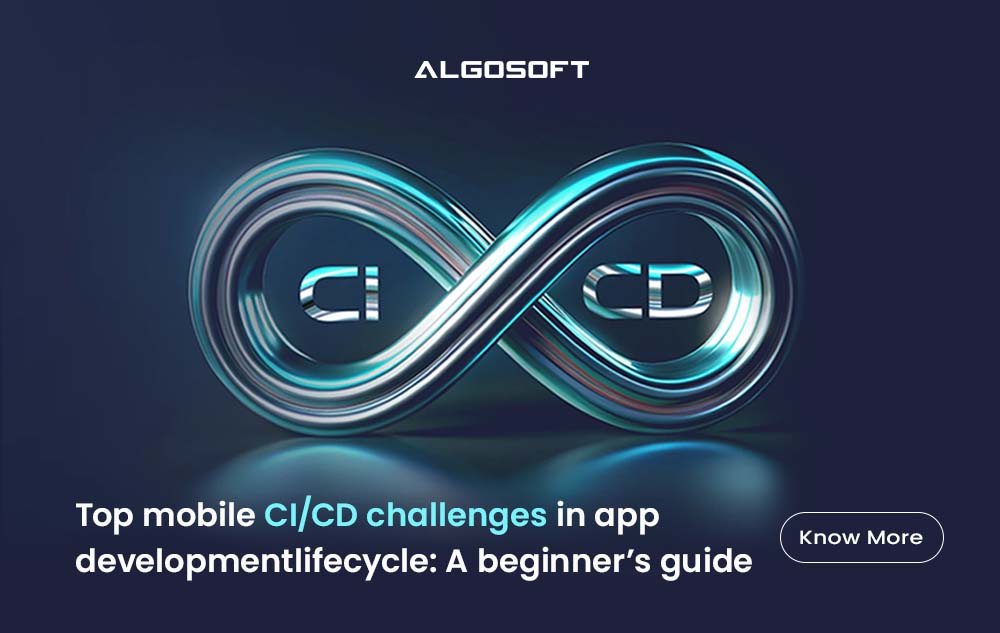App Development
Top mobile CI/CD challenges in app development lifecycle: A beginner’s guide
- Written by
Monika - Posted on
May 20, 2025

The world of app development is fast-paced and ever-evolving. As mobile technology continues to advance, so does the need for efficient processes that can keep up with user demands. Enter Continuous Integration and Continuous Deployment (CI/CD). This methodology has revolutionized how developers approach their projects, allowing for smoother workflows and quicker releases.
But what about those diving into this realm? The journey through mobile CI/CD isn’t without its bumps in the road. For beginners, understanding the basics and tackling common challenges can feel daunting. Yet, mastering these hurdles is essential for creating high-quality apps that stand out in a crowded marketplace.
Whether you’re just starting your app development journey or looking to refine your CI/CD process, navigating these challenges will set you on a path toward success. Let’s explore what it takes to streamline your app development lifecycle with confidence!
Mobile CI/CD is all about automating the stages of app development. It combines Continuous Integration and Continuous Deployment to enhance efficiency.
Continuous Integration focuses on merging code changes frequently, allowing developers to detect issues early. This practice fosters collaboration among team members and minimizes integration problems down the line.
On the other hand, Continuous Deployment ensures that new features or fixes are automatically deployed once they pass testing phases. This streamlines updates and keeps users engaged with fresh content.
Both elements work together harmoniously in a mobile app’s lifecycle. With CI/CD in place, you can release quality updates faster while maintaining stability across various devices and platforms.
Understanding these basics sets the foundation for a successful development strategy in today’s competitive landscape. As technology evolves, embracing these practices becomes increasingly vital for any developer aiming to thrive in app development.
Continuous Integration and Continuous Deployment (CI/CD) play a pivotal role in app development. They streamline the workflow, allowing developers to integrate code changes frequently. This practice minimizes integration issues that can arise when multiple developers work on the same project.
With CI/CD, testing becomes automatic and immediate. Developers receive prompt feedback about their code’s performance, making it easier to catch bugs early in the process. This proactive approach saves time and resources down the road.
Moreover, CI/CD accelerates delivery cycles. Teams can release features faster while maintaining high-quality standards. Rapid iterations lead to a better user experience as updates reach customers promptly.
Adopting CI/CD fosters collaboration among team members. It encourages communication and transparency throughout the development lifecycle, creating a more cohesive working environment focused on shared goals.
Setting up a CI/CD pipeline for mobile app development can feel daunting. Many beginners struggle with the initial configuration due to the diverse tools and platforms available.
First, choosing the right CI/CD tool is crucial. With options like Jenkins, CircleCI, or GitHub Actions on the table, each comes with its own set of features and complexities.
Next comes integration with version control systems like Git. Beginners often face issues syncing their repositories correctly. Misconfigurations here can lead to frustrating delays.
Moreover, environment setup poses another hurdle. Ensuring that build environments match production settings is essential yet tricky. Missing dependencies or incorrect configurations can derail progress quickly.
Understanding platform-specific requirements adds another layer of complexity. Whether you’re targeting iOS or Android—or both—each has unique guidelines that must be followed meticulously for successful builds and deployments.
Integrating mobile applications with various platforms can pose significant challenges. Each platform, whether iOS or Android, has its own set of requirements and configurations.
Developers often face issues related to different SDK versions. Keeping up with updates is crucial, as outdated tools can lead to compatibility problems.
APIs also play a critical role in integration. If an API doesn’t work seamlessly across platforms, it can hinder app performance and user experience.
Cross-platform frameworks might seem like a solution but come with their own complexities. While they help streamline development, they sometimes lack full support for native features specific to each operating system.
Testing becomes another hurdle when ensuring that integrations function correctly on all devices. It requires thorough checks to identify any discrepancies before launch.
These integration challenges require careful planning and proactive strategies for successful app development.
Testing and debugging are crucial steps in the app development lifecycle. A solid approach can save time and resources.
Start by automating testing whenever possible. Automated tests allow for quick feedback, making it easier to identify issues early on. Use unit tests, integration tests, and UI testing tools tailored for mobile platforms.
Don’t overlook manual testing either. It brings a human touch that automation sometimes misses. Real users often spot issues that automated scripts may overlook.
Additionally, leverage logging frameworks effectively during debugging sessions. They provide insights into your app’s behavior in real-time, helping you pinpoint problems faster.
Collaboration is key too; ensure developers work closely with QA teams throughout the process. This fosters an environment where everyone shares responsibility for quality.
Make use of analytics post-deployment to monitor user interactions and performance metrics continuously. This ongoing vigilance helps catch bugs before they escalate into larger issues down the line.
Security in the CI/CD pipeline is crucial for successful app development. As you automate processes, vulnerabilities can arise at every stage. Paying attention to these risks is essential.
Start by integrating security tools into your workflow early on. Automated scanning for vulnerabilities can catch issues before they reach production. This proactive approach saves time and resources down the line.
Another key aspect is managing access control effectively. Limit permissions based on roles within your team. This reduces potential threats and keeps sensitive data protected.
Regular audits of your code and dependencies are also necessary. They help identify outdated libraries or frameworks that could become entry points for attacks.
Foster a culture of security awareness among all team members. Encourage discussions about best practices and emerging threats relevant to mobile app development.
Deployment hurdles can be daunting in the app development process. Often, these obstacles stem from platform fragmentation. Different devices and operating systems may require specific configurations.
Automating your deployment pipeline can significantly ease this challenge. Tools like Fastlane or Bitrise streamline the release process across multiple platforms. This reduces human error and accelerates deployments.
It’s also essential to establish robust version control practices. Maintaining clear documentation of changes helps teams navigate potential conflicts during deployment.
Additionally, testing is vital before deploying updates to production environments. Using staging servers allows developers to catch issues early on without affecting end users.
Communication within the team cannot be overstated. Regular sync-ups keep everyone aligned and ready for unexpected challenges that might arise during the deployment phase.
Continuous improvement is essential in mobile CI/CD. Regularly analyze your pipeline to identify bottlenecks or inefficiencies.
Solicit feedback from your development team frequently. Their insights can lead to innovative solutions and enhance collaboration.
Implement automated testing early in the process. This allows for quicker identification of bugs, ensuring higher quality apps.
Maintain open lines of communication among all stakeholders involved. A unified approach fosters a more agile response to changes and challenges.
Stay updated with industry trends and tools that can optimize your workflow. Embracing new technologies often leads to significant improvements.
Encourage a culture of experimentation within your team. Testing out different methodologies can reveal what works best for your specific app development needs.
Mastering mobile CI/CD challenges requires a strategic approach. It’s about embracing flexibility while maintaining quality.
One key aspect is continuous learning and adaptation. As new tools and technologies emerge, staying updated can significantly enhance your pipeline’s efficiency.
Collaboration within teams fosters better communication. When developers, testers, and operations work seamlessly together, issues are identified early on.
Automation plays a crucial role as well. Automating repetitive tasks allows teams to focus on more complex problems that require human insight.
User feedback should not be overlooked. Regularly integrating user insights into the CI/CD process ensures that the final product meets expectations and keeps evolving with market demands.
By addressing these elements head-on, overcoming hurdles in mobile app development becomes achievable.
Take your business to new heights by offering unmatched mobility to your customers!


Privacy Policy I Terms & Conditions
© Algosoft Apps Technologies (P) Ltd. (CIN) U93030UP2015PTC075117
Share this article